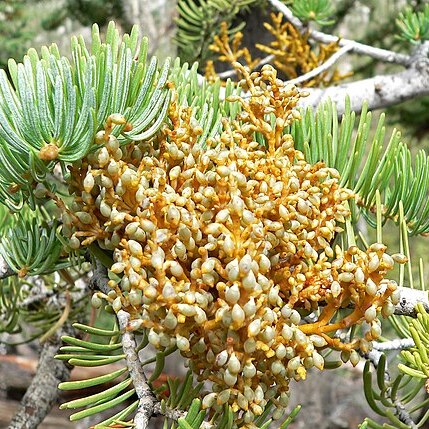Herbs or shrubs from 0.5 cm. to ± 70 cm. high, parasitic on coniferous trees of the Pinaceae or Cupressaceae; plants glabrous, variously coloured from greenish yellow to orange, reddish or black, dioecious; stems with a central xylem cylinder; internodes angled, at least when young. Leaves reduced to minute, opposite, connate scales. Flowers generally decussate or rarely whorled on young shoots, 2–4 mm. in diameter. Staminate flowers with a central nectary; tepals (2–)3–4(–7), bearing a sessile, uniloculate circular anther on each tepal. Pistillate flowers manifestly epigynous; tepals 2, persistent, adnate to ovary. Fruit an elongate berry, 1-seeded, mucilaginous, bicoloured (separated by the equatorial line), explosive at maturity. Seeds usually 1–5 mm. long, ovate-lanceolate, containing a single cylindrical embryo, or sometimes polyembryonic, and with copious endosperm.
Subshrubs or herbs parasitic on gymnosperms, dioecious. Branches dichotomous or verticillate; stem internodes terete. Leaves reduced to scales, decussate, in 4 ranks, connate. Flowers axillary or terminal on branchlets, decussate or whorled; peduncle absent; pedicel short to nearly absent. Male flower subglobose or ovoid in mature bud; perianth lobes 3 or 4, ± rotate. Anthers sessile, inserted on perianth lobes, circular, 1-loculed, dehiscence transverse; central nectary present. Pollen grains subprolate, 3-lobed to circular in polar section. Female flower ovoid to ellipsoid in mature bud, epigynous; perianth tube short, 2-lobed, adnate to ovary, persistent. Placentation free, central. Style short; stigma obtuse. Berry ovoid or ellipsoid, apex different in texture from base, exocarp smooth, explosively dehiscent at maturity.
Dioecious; fls solitary or few in the axils of scale-like, connate, decussate lvs; staminate perianth 2–5-lobed; anther sessile at the middle of each lobe, opening transversely; pistillate perianth 2-lobed; berry on a short, recurved pedicel. 28, mainly of N. Amer.

